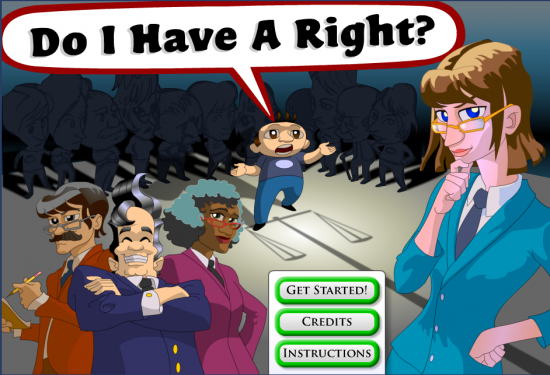One game
that I might have students play at home for autonomous learning and to reinforce what they are doing
in school would be the Bill of Rights game “Do I Have a Right?” which I found on the GameChange website. This game would be categorized as a serious game. Serious
Games are computer and video games that are intended to not only entertain
users, but have additional purposes such as education and training. I think that this game reinforces and teaches
about the bill of rights and constitutional law. I played this game about three or four times
and really felt that it helped teach what rights are contained in the
Bill of Rights and other constitutional amendments.
In the game, students manage a law firm
staffed with lawyers who specialize in constitutional law and must decide
whether each visiting client “has a right” after reading about the client's
problem or issue. If so, students match the client with a lawyer
who specializes in the relevant constitutional amendment.
Students
grow their law firms over a series of 8-hour “days”. Their successes increase the
lawyers’ number of specializations and earn them points to hire more lawyers
and buy a variety of amenities to keep waiting clients happy.
But the clock is
ticking, and students have to learn their amendments fast if they want to keep
winning cases and stop clients from walking out.
As
additional learning features, the game allows students to click on
relevant information in the client descriptions and awards points when
the students find information that is relevant to the problem.
Also, at the end of each day (or round), a newspaper appears that summarizes the successes and failures of the day. This provides additional reinforcement of what students are learning and practicing while playing the game.
The learning objectives for this game would be:
- The students will be able to distinguish which issues are rights and which are not based on a written description.
- The students will be able to identify which part of the bill of rights gives them that right.
This could
be assessed with a teacher created quiz based on the scenarios in the game or a
matching quiz. The game also has a
feature whereby if the students are signed in to the game, they can see a final
score breakdown. From there, students
can view and print a detailed report that will let the teacher determine how students
performed on each specific amendment.
One of the nice things about the game is that although students with some background and familiarity with constitutional rights may find it easier to play, "Do I Have a Right?", it also teaches the constitutional amendments, so even those who don't know much about the Bill of Rights can play and learn!







